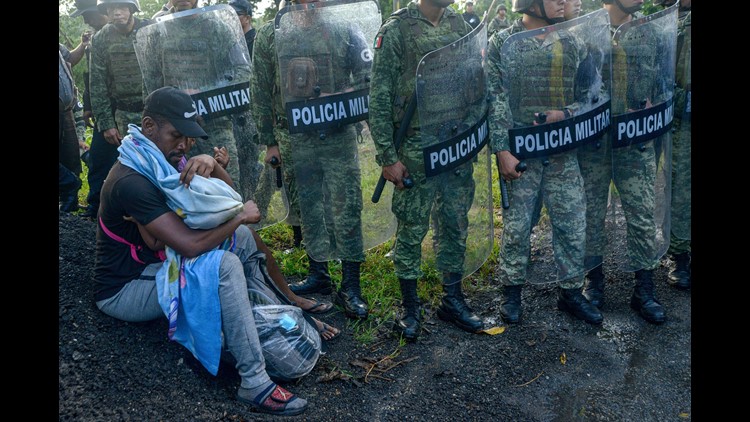The commander paces in front of a line of troops, preparing them for the day’s mission.
“We are in our country. We are in Mexico. We are enforcing our laws,” he says, his voice getting louder with each point he makes.
“Nobody is going to come here to trample on our laws,” he continues. “Nobody is going to come here to trample on our country, on our land.”
Soon afterward, according to local media reports, military police from Mexico’s National Guard blocked a large group of migrants in Tuzantán, Mexico, who had been trying to head north. The caravan, made up of thousands of migrants largely from Africa, Central America and the Caribbean, was disbanded and sent to an immigrant detention camp in southern Mexico.
A video of the October 12 operation went viral and stirred a mix of reactions in Mexico, adding fresh fuel to a point critics of President Andres Manuel López Obrador have been making for months.
Mexico, they argue, actually built US President Donald Trump’s border wall after all — not with concrete or bricks or steel, but with thousands of federal forces like this camouflage-clad commander and the troops following his orders.
And Mexico, they argue, is paying for it.
Trump: ‘Mexico is showing us great respect’
Yes, US taxpayers have been footing the bill for efforts to build new physical barriers at the US-Mexico border.
But experts note that Mexico’s massive deployment of National Guard troops over the past few months has played a major role in blocking migrants from reaching the US border in the first place. It’s a point Trump himself has made at several recent events — a dramatic change in tone from his sharp criticisms of Mexico earlier this year.
“I would like to thank President López Obrador of Mexico for the great cooperation we are receiving, and for right now putting 27,000 troops on our southern border,” Trump told the United Nations General Assembly last month. “Mexico is showing us great respect, and I respect them in return.”
A few days later, Trump told reporters he was “using Mexico to protect our border” because Democrats weren’t doing enough to fix the immigration system.
And last week, acting US Customs and Border Protection chief Mark Morgan praised Mexico on Twitter, sharing a news story about the October 12 operation to turn back the latest caravan.
“Mexico’s enhanced border security efforts along their southern border continue to have a dramatic impact on this regional crisis,” he wrote. “I just returned from Mexico where we had collaborative discussions on stemming the flow of illegal migration throughout the region.”
Not everyone is praising the increased collaboration.
The recent video of the National Guard’s response to the caravan of migrants from Central America and Africa drew backlash on social media.
“We criticize Trump for his anti-immigrant stance and our National Guard is doing exactly the same thing,” tweeted Mexican columnist Denise Dresser, who has criticized the troops’ response to migrants in the past.
In a recent New York Times column — headlined “Mexico is the wall” — Univision anchor Jorge Ramos noted that Trump’s comments that he was “using Mexico” had riled many Mexicans.
“It’s true: President Trump is using Mexico. And, against all logic, Mexico is letting him get away with it,” he wrote. “This has to change.”
Thousands of troops deployed
Asked to respond to claims that Mexico is effectively paying for the wall Trump wanted, foreign ministry spokesman Roberto Velasco told CNN that migration flows have notably decreased in recent months, and that efforts continue for a regional development plan to address the root causes of migration in Mexico, El Salvador, Guatemala and Honduras.
“The number of migrants presented before Mexican authorities has decreased by 70% from June to September,” he said.
The decrease, he wrote in a recent letter to the editor published in Mexico’s El Universal newspaper, came as a result of Mexican legislative efforts and a push to strengthen the rule of law in southern Mexico.
As the Trump administration threatened to impose tariffs, Mexican officials in June agreed to step up their country’s immigration enforcement.
López Obrador has said he had no choice but to negotiate.
“We represent our country with dignity, and we have nothing to be ashamed of,” he said in September. “The sovereignty of Mexico is defended. At the same time, we do not want confrontation. We have a frank, open hand extended to all the governments of the world, and we embrace all the peoples of the world, and we are especially interested in a good relationship with the United States.”
Nearly 15,000 troops are deployed to Mexico’s northern border, where they’ve set up 20 checkpoints, Mexican Defense Minister Luis Cresencio Sandoval said last week at a press briefing on the country’s security strategy. At the southern border, 12,000 troops are deployed and have set up 21 checkpoints.
Military helicopters regularly conduct aerial reconnaissance in both border regions, he said. So far, Cresencio said, more than 60,000 migrants have been intercepted as part of the effort.
At the same press conference, officials noted that the number of migrants seeking asylum in Mexico has increased dramatically, with some 80,000 asylum applications expected by the end of this year.
Officials also touted Mexico’s first transatlantic deportation flight last week. A charter flight with more than 300 Indian nationals aboard flew from Toluca, Mexico, to New Delhi, Mexico’s National Migration Institute said Wednesday.
‘The message on the ground’
Analysts told CNN the video of efforts by Mexican authorities to block the recent caravan is a revealing window into how Mexico’s shifting policies are unfolding.
“The message given is that Mexico is not interested in protecting people that are in need,” says Gretchen Kuhner, director of the Institute for Women in Migration, a Mexican advocacy organization. “The message given by this general is not the official message of the government, but it explains very well what the message on the ground is.”
Ana Maria Salazar, a former US deputy assistant defense secretary who’s now a security analyst based in Mexico, says images of the operation illustrate concerns critics had when Mexico’s National Guard was swiftly formed and deployed this year.
“This is someone who was trained to protect the national sovereignty, not someone who handles migrants. And these are the worries in forming a National Guard so hastily,” she said. “You can’t expect that from one day to the next, a soldier that is trained to protect the territory against enemies of the state will now be responsible for people that are trying to cross illegally into the country. These are very different missions and this is reflected in the images and what the commander says.”
In some ways, Salazar says, López Obrador is doing Trump’s bidding when it comes to his government’s handling of migrants. Such strict immigration enforcement along Mexico’s southern border hasn’t been seen before, she adds.
But Salazar says that López Obrador, unlike his predecessors, has “so much credibility in Mexico that he can assume the political costs of this decision.”
In the past, she says, presidents would have been attacked for taking such steps, and international pressure would have mounted.
“That pressure, which was there for former Mexican governments,” she says, “has been extremely silent on the decisions of this government.”
In fact, public opinion toward migrants in Mexico appears to be shifting, too.
A poll conducted by the Washington Post and Mexican newspaper Reforma over the summer showed a sizable majority of Mexicans felt that increased migration through the country from Central America was a burden on Mexico’s economy and services. Just over half favored deporting more migrants.



